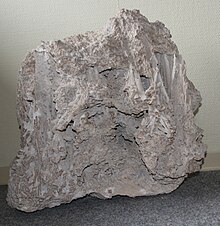Duckstein (rock)
Duckstein is a common regional name in the Elm (mountain range) , Lower Saxony ( Helmstedt district and Wolfenbüttel district ) for a type of stone (origin: "roof" or " capstone ") that is no longer used in construction today. Duckstein originated in the Pleistocene and is around 200,000 years old.
Sedimentary rock
In the Elm, Duckstein describes a secondary sediment, which was chemically precipitated as tufa from the limestone there . In geology, the terms Kalktuff (also tubular tuff), travertine and limestone sinter are used to differentiate or synonymously for spring lime, inconsistent . The entire old town of Königslutter stands on a layer of duck stone, which is about 2-3 meters on average and at most eight meters thick . The further the Lutter , a stream, flows down through the city, the finer the Duckstein becomes and it is loosely connected there. This loose rock was popularly called abrasive sand in the past and was used to clean the wooden floorboards .
use
The Duckstein was used regionally as a brick for building houses. In earlier times, for example, houses were built on the rock. The cellars of these buildings were carved into the soft duck stone and the broken stones were used for masonry. In the breaking state, the Duckstein is easy to work with and can also be formatted with hand saws. It hardens in the air and forms a solid building block that has been built into entire rows of houses or walls in Königslutter. The state hospital Königslutter, which is located south of the imperial cathedral of Königslutter , was built largely from Duckstein, whereby Duckstein was mainly used as brick and the window and door jambs were formed from the more pressure-resistant Elm limestone .

In the 18th century, Duckstein found a sale as an ornamental stone for the grottoes of the pleasure palace in Salzdahlum . The cool cellars in Duckstein were used by the earlier breweries in Königslutter to store top-fermented Duckstein beer . This type of beer got its name from Duckstein. For the production of beer, the Lutterbach was diverted to the breweries in small channels made of Velpker sandstone . Lime was precipitated and deposited in a short period of time in a layer with a thickness of up to about 10 cm on the ground and on the wall sides of the sandstones .
literature
- Jochen Lepper: Building and monument stones between Elm and Aller - occurrence and use. Excursion guide Natural History Society Hanover. October 8, 2005. Self-published.
Individual evidence
- ^ Heinz Röhr: History of a landscape and people. Our homeland / Volume IV. Edited by Wolfenbüttel district. Hans Oeding publishing house. Braunschweig-Schöppenstedt 1962.

